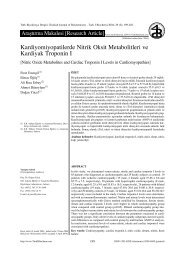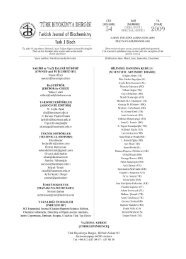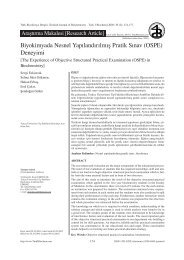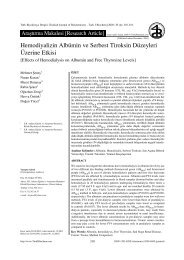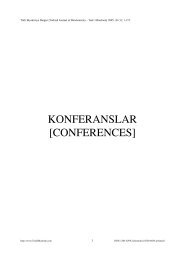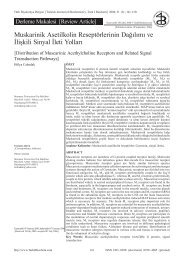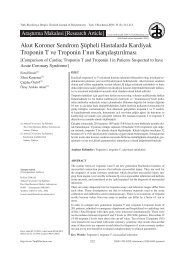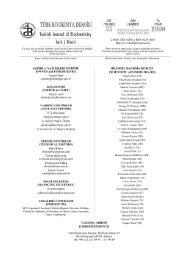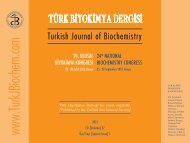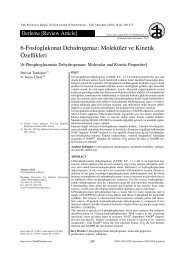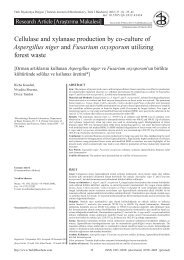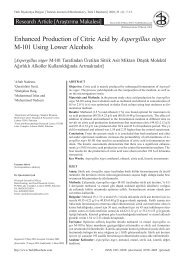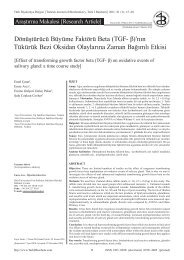23. Ulusal Biyokimya Kongresi Ãzel Sayısı - Türk Biyokimya Dergisi
23. Ulusal Biyokimya Kongresi Ãzel Sayısı - Türk Biyokimya Dergisi
23. Ulusal Biyokimya Kongresi Ãzel Sayısı - Türk Biyokimya Dergisi
Create successful ePaper yourself
Turn your PDF publications into a flip-book with our unique Google optimized e-Paper software.
XXIII. ULUSAL B‹YOK‹MYA KONGRES‹<br />
29 Kasım - 2 Aralık 2011<br />
Hilton Hotel - Adana<br />
<strong>23.</strong> <strong>Ulusal</strong> <strong>Biyokimya</strong> <strong>Kongresi</strong>, Adana [23 rd National Biochemistry Congress, Adana / TURKEY]<br />
İÇİNDEKİLER<br />
P. 169 / TARÇIN, KİMYON VE SUMAK ADLI BAHARAT<br />
TÜRLERİNDEN ELDE EDİLEN SU, ETANOL-SU, METANOL VE<br />
KLOROFORM EKSTRAKTLARININ İN VİTRO ANTİOKSİDANT<br />
ÖZELLİKLERİNİN BELİRLENME<br />
Ozlem AYDIN1, Fehmi ODABAŞOĞLU1, Mesut HALICI2, Ahmet ÇAKIR3<br />
P. 169 / THE DETERMINATION OF THE ANTIOXIDATIVE<br />
PROPERTIES OF WATER, ETHANOL-WATER, METHANOL AND<br />
CHLOROFORM EXTRACTS OBTAINED FROM CINNAMON, CUMIN<br />
AND SUMAC, IN VITRO<br />
Ozlem AYDIN 1 , Fehmi ODABAŞOĞLU 1 , Mesut HALICI 2 , Ahmet ÇAKIR 3<br />
CONTENTS<br />
1 Atatürk Üniversitesi, Eczacılık Fakültesi, <strong>Biyokimya</strong>, Erzurum<br />
2 Atatürk Üniversitesi , Veterinerlik Fakültesi, <strong>Biyokimya</strong>, Erzurum<br />
3 Kilis 7 Aralık Universitesi, Fen Fakültesi, Kimya, Kilis<br />
1 Biochemistry, Faculty of Pharmacy, Ataturk Univ. Erzurum<br />
2 Biochemistry, Faculty of Veterninary, Ataturk Univ., Erzurum<br />
3 Chemistry, Kilis 7 Aralık Univ. , Erzurum<br />
Bu araştırmada, deney materyali olarak, ülkemizde yaygın kullanım gösteren<br />
baharatlardan tarçın, kimyon ve sumak üzerinde çalışıldı. Baharat örneklerinin her<br />
bir türün su, etanol-su, metanol ve kloroform ekstraktları literatüre uygun yöntemler<br />
kullanılarak elde edildi. Ekstraktların antioksidan aktiviteleri, fenolik bileşik miktarları<br />
ve indirgeme yetenekleri belirlendi. Sonuçlar kontrol grupları ile mukayese edilerek<br />
verildi ve literatürlerle kıyaslanarak tartışıldı. Antioksidant aktivite düzeylerinin,<br />
tarçın ve kimyonun su ekstraktlarında en yüksek, kloroform ekstraktlarında en düşük<br />
ve diğer tüm ekstraktlarda ise orta düzeyde olduğu tespit edildi. Ekstraktların toplam<br />
fenolik bileşik miktarlarının; sumağın metanol ve etanol-su ekstraktlarında en yüksek,<br />
kloroform ekstraktlarında en düşük ve diğer bütün ekstraktlarda değişen seviyelerde<br />
olduğu belirlendi. Ölçümlerimiz; ekstraktların indirgeyici güçlerinin, sumak metanol<br />
ekstraktında en yüksek, kloroform ekstraktlarında en düşük ve diğer bütün ekstraktlarda<br />
değişen düzeylerde olduğunu gösterdi.<br />
In this research; as experiment material, also spices such as cinnamon, cumin and<br />
sumac widespread using in our country were investigated. The water, ethanol-water,<br />
methanol and chloroform extracts of each type of spices samples were produced<br />
using appropriate methods according to literature. We determined the antioxidant<br />
activities, phenolic compound amounts and reducing powers of these extracts. Results<br />
were presented to compared with control groups, were discussed as comperative with<br />
literatures. The antioxidant activity assay showed that it is the highest levels in water<br />
extracts of cinnamon and cumin, lowest levels in chloroform extracts, and moderate<br />
levels in other extracts.In ethanol-water and methanol extracts of sumac, amounts of<br />
total phenolic compounds were the highest levels. Entire of chloroform extracts had<br />
the lowest in its amounts. On the other hand, their amounts were in varying levels<br />
in all of other extracts. Our results; of reducing power assays showed the highest<br />
levels in methanol extract of sumac, the lowest levels in all of chloroform extracts.<br />
Notwithstanding it was in different levels in the other extracts. As a result; in this<br />
study, the all of species spices which we used as experimental material, demonstrated<br />
potentially antioxidative properties. Further, these results will be primarily developed<br />
leading to biological activity studies.<br />
Turk J Biochem, 2011; 36 (S2)<br />
http://www.TurkJBiochem.com



